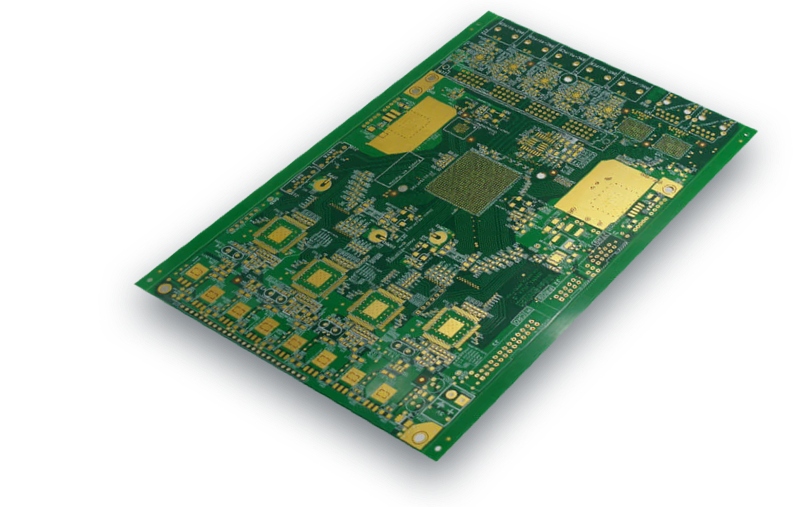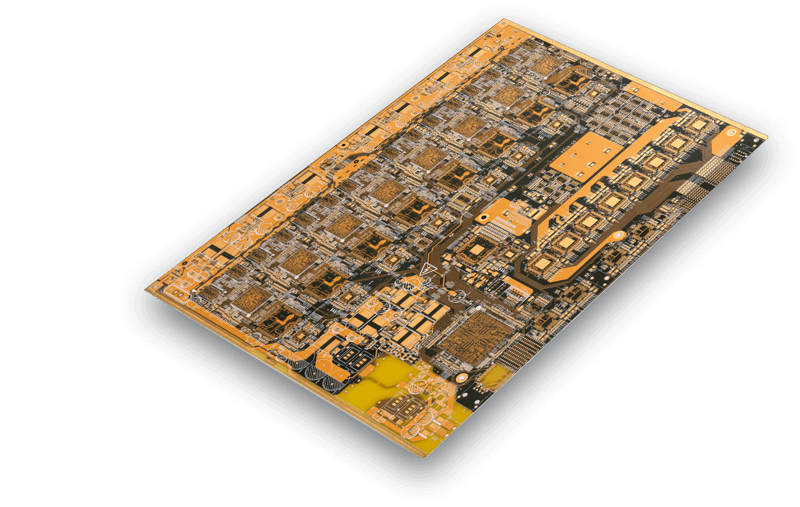HDI PCB
- HDI stands for High-Density Interconnect. In other words, a PCB with about 120 – 160 pins per square inch is an HDI PCB.
- The HDI PCB has multiple interconnections enclosed within a small space, reducing the size of a circuit board.
- HDI made the microvia technology famous and it’s perfectly ideal for blind vias, microvias, and buried vias.
- Professional engineer review; strict quality control for each process.
- Advanced Testing Technology To Ensure the Quality such as AOI Test, E-Test, X-RAY, Impedance Control.
- We committed to helping customers get the highest quality products and services with competitive prices (especially multilayers PCBs).
- FR4,High TG FR4, High-frequency Material, Rogers PCB, Metal based PCB.
- FR4,High TG FR4, High-frequency Material, Rogers PCB, Metal based PCB.
- FR4,High TG FR4, High-frequency Material, Rogers PCB, Metal based PCB.
- Superior customer service (personal to personal).
What Is an HDI PCB?
The HDI application is one of the fastest-growing technologies today. HDI PCB’s stands for High-Density Interconnect Printed Circuit Boards. So, it results in the reduction of a circuit board. Moreover, there’s little space between the PCB components, making the board space smaller—although the board functionally isn’t affected.
In other words, a PCB with about 120 – 160 pins per square inch is an HDI PCB. So, the design of the HDI integrates versatile routing and density component placement. Also, it’s essential to know that HDI made the microvia technology famous and it’s perfectly ideal for blind vias, microvias, and buried vias.
The 3 Ways to Designing a
Successful HDI PCB
There are three key ways to design HDI PCB with success.
And they are as follows:
1. Manufacturing Process
Aperture Ratio
You can’t successfully build an HDI PCB without knowing the aperture ratio you intend to use for its fabrication.
However, a general rule of thumb is using a smaller aperture for a thicker board and vice-versa.
Stack
Process Flow
2. Layout
Generally, the HDI PCB layouts have a high density. Hence, it’s necessary to ensure their maintainability, solderability, and instability.
3. Tracking
HDI PCB manufacturing capabilities
(Up to 32 Layers)
The Different Types of
HDI Printed Circuit Boards Structures
-
FeatureCapacity
-
Number of Layers :1 - 32 layers
-
Time of Production:1 day - 4 weeks
-
Quality Grade:Standard IPC 2
-
Order Quantity:1pc - 10000+pcs
-
Copper Weight (Finished):6oz/10oz
-
Board Size:Min 50*50mm | Max 450*406mm
-
Material:FR4 standard Tg 140°C,FR4 High Tg 170°C, FR4 and Rogers combined lamination
-
Board Thickness:0.2mm - 10mm
-
Silkscreen Color:White, Black, Yellow
-
Solder Mask Color:Green, Black, Blue,White, Red, Yellow
-
Min Tracing/Spacing:2.5mil/2.5mil
-
Solder Mask Sides:As per the file
-
Silkscreen Sides:As per the file
-
Max Exponents of Blind/Buried Vias:Stacked vias for 3 layers interconnected, staggered vias for 4 layers interconnected
-
Min Annular Ring:4mil, 3mil - laser drill
-
Other Methods:Flex-rigid combination Via In Pad Buried Capacitor (only for Prototype PCB total area ≤1m²)
-
Surface Finish:HASL- Hot Air Solder Leveling Lead Free HASL - RoHS ENIG - Electroless Nickel/Immersion Gold - RoHS Immersion Silver - RoHS Immersion Tin - RoHS OSP - Organic Solderability Preservatives - RoHS
-
Min Drilling Hole Diameter:6mil, 4mil - laser drill
We’re also capable of fabricating up to 32 layers of HDI PCB. So, it all depends on your specific demands. Below, is the table showing the type of HDI PCB structures we create.
| HDI PCB Structures | The Various categories of Micros Vias | Large-Scale Production | Small to Medium-Scale Production | Prototype | Available |
|---|---|---|---|---|---|
| 1+N+1 | Blind vias | Yes | Yes | Yes | Over 4 layers |
| 2+N+2 | Blind/Buried staggered vias | Yes | Yes | Yes | Over 6 layers |
| 2+N+2 | Blind/Buried stacked vias | Yes | Yes | Yes | Over 6 layers |
| 3+N+3 | Blind/Buried stacked vias | / | Yes | Yes | Over 8 layers |
| 3+N+3 | Blind/Buried stacked vias | / | / | Yes | Over 8 layers |
- Prototype orders placed within 24 hours
- Normal lead time (5-7 working days for some PCBs prototypes and small batch production)
- Faster lead time (48 hours for some PCBs prototypes and small batch production)
What Are the Benefits of
using HDI PCB?
–The benefits of HDI PCB are as follows:
Better Signal Veracity
- Because HDI integrates blind via tech and via-in-pad, it helps put the PCB components together without cutting down the signal path length. Thus high-density PCBs have a faster signal transmission without much signal loss.
- Also, HDI tech eliminates via stubs. Hence, it limits signal reflection and boosts the quality of the signal.
Affordable
- A standard 8-layer PCB can reduce to a 6-layer PCB without dropping the quality level. By doing so, you'll be saving a few bucks.
Compact Design
- The grouping of hole vias like micro vias, blind vias, and buried vias, reduces the requirement for board space.
High Dependability
- The integration of stacked vias makes HDI boards highly resistant to extreme environmental conditions because of the super shield.
Extraordinary Adaptability
- HDI boards are suitable for boards that consider space, weight, performance, and reliability as their key concern.
What is the Future for HDI PCB?
From the look of things, HDI PCBs are creating a lot of possibilities in a wide range of industries. And it can only develop as time passes.
So, it’s a technology that you should consider—especially if you need something that will save you time and boost your efficiency. Plus, the demand for the HDI PCB increases regularly. So, we can tell that it’s promising.
Are you interested in getting more information about HDI PCB?
What Is the Difference between
Standard and HDI PCBs?
The standard PCBs use through-holes. So, they have a high stray capacitance and a colossal discontinuity in impedance. In other words, standard PCBs have decent signal integrity performance.
But, the HDI uses buried vias and small blind. Hence, it decreases the stray inductances and capacitances. Plus, it offers excellent signal integrity performance. Other vital differences between the standard and HDI PCB include:
-
Through-Hole PCB (Standard):HDI PCB
-
It has a lower component density per square inch:HDI has a higher component density per square inch compared to standard PCBs
-
Uses mechanical drilling:HDI uses direct laser drilling
-
Standard PCBs have heavier and larger boards:It has lighter and smaller boards with increased functionality
-
Comes with a high number of layers:Features a low number of layers
-
Standard PCBs use through-holes:HDIs use microvias, blind, and buried vias
-
When paired with low pitch packages, it faces a few compatibility problems:It works perfectly with low pitch packages and high pin count
HDI PCB Application
Automotive industry
- Technology has pushed the automotive industry to work towards a few goals.
- They help to improve the driving experience and to save some space in vehicles. With that said, it’s no surprise that manufacturers cling to the small-sized PCBs (HDIs) to achieve the goal.
Health Care Sector
- HDI PCBs have revealed a lot of possibilities in the medical field. After all, HDIs play a massive role in diagnosing diseases. An excellent example of medical equipment or medical devices that uses the HDI is pacemakers.
Consumer Electronics industry
- Your everyday consumer devices are practically a part of you. So, it doesn’t matter if it’s your VR headset, tablet(touch-screen devices), smart watch(Wearable Technology), personal computers/portable computers(laptop computers), entertainment systems, smartphone(mobile devices), or home appliances. All these gadgets have an HDI. Besides, the HDI is responsible for the exceptional functionality you enjoy from your electronic devices. Plus, the HDI PCBs promote portability. For instance, HDI PCBs help to produce compact electronic products. But, as a manufacturer, it’s vital to follow the regulations with caution. That way, you’ll avoid creating designs that deter your devices’ quality.
Industries
- Asides from that the HDI PCBs can withstand extreme conditions, they consume less energy. And while that happens, it produces maximum output. That’s why this PCB is useful in industries. You can find the HDI PCB in industrial equipment like electric drills.
Products Show




Testimonial



Top Questions
1. What services do you offer?
Three basic PCB assembly services are offered, including PCB Fabrication, Consigned PCB Assembly, and Full Turnkey Service.
2. Is it possible to get stack-up drawings from you?
Yes, we have shared some of our standard stack-up drawings with you or even individual stack-up drawings meeting your special requirements.
3. Do you offer any discounts?
Our two factories have price support for different orders, especially multilayer boards and mass production.
4. No, we generally work on the basis of the Gerber file.
No, we generally work on the basis of the Gerber file.
5. What if I am dissatisfied with PCBs from WELLPCB.com?
If you find any defects with the PCBs delivered, or if you feel dissatisfied with our products or services, please immediately let us know via [email protected], and we will respond within 24 hours. We will serve you until you are fully satisfied. We will either re-fabricate your PCB in case of a defect or refund the full amount without needing to return the defective PCBs. You may also choose to credit your WELLPCB.com account and use the credit for future orders.
6. What else to consider when manufacturing High-Density boards(HDI PCBs)?
Besides what we have covered above, it is also essential to consider the electrical performance, such as electrical connection, connection pad density, density per unit, etc. For more questions, you are welcome to contact our team.